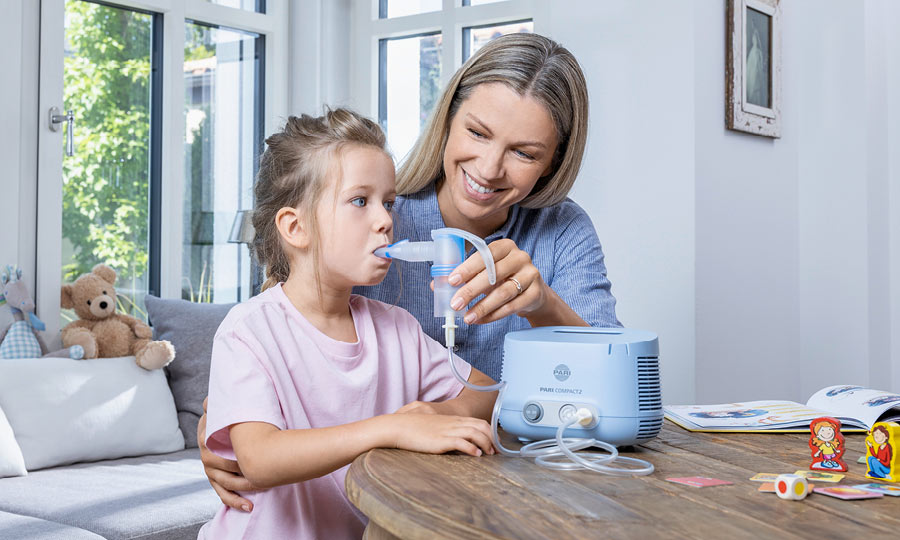Nebulisers generate a fine mist - so called ‘aerosol’ - from medications or saline solutions to treat respiratory issues. Selecting the appropriate nebuliser for your specific needs and proper use is crucial. This page provides information on different types of nebulisers commonly used in the UK and their proper use. In addition, we discuss how to choose the best nebuliser for you.
There are different types of nebulisers. All of them create a fine mist - so called ‘aerosol’ - from inhalation solutions and deliver it to the airways. The nebuliser is only one part of a nebuliser system that is often referred to as a nebuliser machine.
The nebuliser (or nebuliser ‘chamber’) is what generates the aerosol, so it is the most vital component of the entire nebuliser system. It can create fine or large aerosol particles based on the application: particles under 5 µm (microns) target the lungs, while larger ones treat the trachea (windpipe) and throat.
A jet nebuliser involves a compressor to produce air, a chamber for the nebuliser solution, and tubing to connect the components. In the nebuliser chamber, the inhalation solution is ‘atomised’. The inner baffle in the chamber determines how large the droplets are and for which part of the airways the nebuliser can be used. As they usually run on mains power supply, some people call them a home nebuliser.
High quality jet nebuliser devices such as the PARI BOY Classic or the PARI COMPACT2 are very versatile and durable.
Vibrating mesh nebulisers produce aerosol through a vibrating metal membrane with tiny holes. These membranes, laser-drilled and rigorously quality-controlled for treating respiratory conditions, are expensive to manufacture. Consequently, the price reflects the quality of a vibrating mesh nebuliser.
Vibrating mesh nebulisers, often portable, can operate on mains power or batteries. Models like the PARI VELOX and eFlow®rapid operate very quietly and are extremely fast.
Nebuliser treatment with isotonic saline moisturises the mucosa of the lungs. This supports our defense mechanism of the lung - the so called mucociliary clearance. Nebulising isotonic saline is very gentle and can also be used daily for prevention of colds and flu.
Inhaling nebulised hypertonic saline solution dissolves thick mucus and makes it easier to cough up. It settles on the mucosa and liquefies the mucus. In patients with excess mucus this can make breathing easier.
Medication inhalation can be through dry powder inhalers or sprays. Both may be complex for the elderly and children due to the specific breathing techniques needed. Nebulisers, on the other hand, work with normal breathing.
Sit upright and relaxed. Pour in the nebuliser solution and switch on the device. Breathe in and out in a relaxed manner through the mouthpiece or mask. With an efficient nebuliser the treatment session takes less than seven minutes for 2.5 ml of inhalation solution. Clean the nebuliser after each use.
With nebuliser therapy for the lungs, a mouthpiece outperforms a mask. Children should transition to a mouthpiece by age three whenever possible, sometimes even sooner.
Nebuliser chambers should be changed once a year to ensure an efficient therapy over time. With PARI you can buy Year Packs that come with a filter for your compressor too. So, you get everything you need with your yearly replacement.
All nebulisers need cleaning after use. PARI nebulisers can be cleaned without any chemicals because they can simply be washed using normal washing up liquid and then disinfected in boiling water or a baby bottle steriliser.

What is the best nebuliser to buy in the UK? There is not a straightforward answer to this question. It really depends on your specific condition and requirements. There are, however, some selection criteria that you should consider.
It is about your respiratory health, so make sure to select a high-quality nebuliser from a reputable manufacturer that ensures quality control. The price may reflect the extensive manufacturing and quality processes involved.
The system you choose must be able to deliver the medicine or saline solution where it is needed. Depending on your condition this can be the lungs, the sinuses, or the throat. Therefore, be careful about claims that a nebuliser is suitable for upper and lower airways at the same time.
When a nebuliser is used to treat the lungs, only particles smaller than 5 µm (microns) can make it past your throat & down into the lung. Smaller particles without a powerful compressor lead to longer treatment times. Therefore, use a nebuliser machine that is known to be efficient.
PARI is the original nebuliser company and a trusted brand.
Nebuliser medication is usually provided by the NHS. However, most likely you will have to pay for the nebuliser machine yourself. When paying for it yourself, durability is even more important to consider. Some of our clients have been using their compressor devices for over 20 years.
Nebulisers are just one part of a system. There are different kinds commonly used in the UK. All of them create a fine mist from a liquid that can either be medication or a saline solution. High quality jet nebulisers such as the PARI BOY Classic or the PARI COMPACT2 are very versatile and durable. To summarise, there is not ‘the best nebuliser’, only the best one for you, because you should choose the nebuliser that is suitable for your specific requirements.
Contact us
Any questions? You can reach us at this number:
01932 341122
© 2025 PARI GmbH Spezialisten für effektive Inhalation